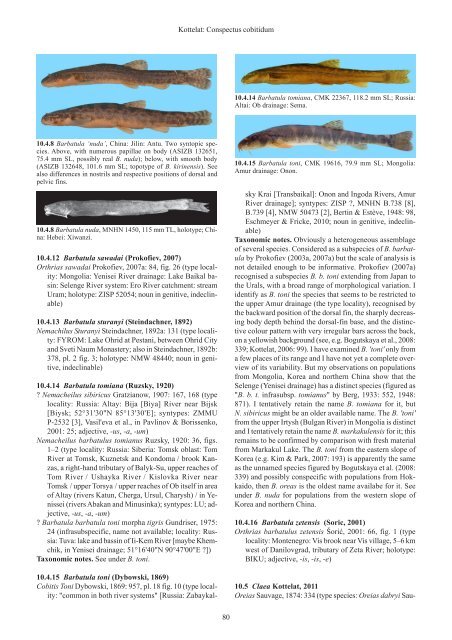Conspectus cobitidum - Raffles Museum of Biodiversity Research
Conspectus cobitidum - Raffles Museum of Biodiversity Research
Conspectus cobitidum - Raffles Museum of Biodiversity Research
Create successful ePaper yourself
Turn your PDF publications into a flip-book with our unique Google optimized e-Paper software.
10.4.8 Barbatula ‘nuda’, China: Jilin: Antu. Two syntopic species.<br />
Above, with numerous papillae on body (ASIZB 132651,<br />
75.4 mm SL, possibly real B. nuda); below, with smooth body<br />
(ASIZB 132648, 101.6 mm SL; topotype <strong>of</strong> B. kirinensis). See<br />
also differences in nostrils and respective positions <strong>of</strong> dorsal and<br />
pelvic fins.<br />
10.4.8 Barbatula nuda, MNHN 1450, 115 mm TL, holotype; China:<br />
Hebei: Xiwanzi.<br />
10.4.12 Barbatula sawadai (Prok<strong>of</strong>iev, 2007)<br />
Orthrias sawadai Prok<strong>of</strong>iev, 2007a: 84, fig. 26 (type locality:<br />
Mongolia: Yenisei River drainage: Lake Baikal basin:<br />
Selenge River system: Ero River catchment: stream<br />
Uram; holotype: ZISP 52054; noun in genitive, indeclinable)<br />
10.4.13 Barbatula sturanyi (Steindachner, 1892)<br />
Nemachilus Sturanyi Steindachner, 1892a: 131 (type locality:<br />
FYROM: Lake Ohrid at Pestani, between Ohrid City<br />
and Sveti Naum Monastery; also in Steindachner, 1892b:<br />
378, pl. 2 fig. 3; holotype: NMW 48440; noun in genitive,<br />
indeclinable)<br />
10.4.14 Barbatula tomiana (Ruzsky, 1920)<br />
? Nemacheilus sibiricus Gratzianow, 1907: 167, 168 (type<br />
locality: Russia: Altay: Bija [Biya] River near Bijsk<br />
[Biysk; 52°31'30"N 85°13'30'E]; syntypes: ZMMU<br />
P-2532 [3], Vasil'eva et al., in Pavlinov & Borissenko,<br />
2001: 25; adjective, -us, -a, -um)<br />
Nemacheilus barbatulus tomianus Ruzsky, 1920: 36, figs.<br />
1–2 (type locality: Russia: Siberia: Tomsk oblast: Tom<br />
River at Tomsk, Kuznetsk and Kondoma / brook Kanzas,<br />
a right-hand tributary <strong>of</strong> Balyk-Su, upper reaches <strong>of</strong><br />
Tom River / Ushayka River / Kislovka River near<br />
Tomsk / upper Torsya / upper reaches <strong>of</strong> Ob itself in area<br />
<strong>of</strong> Altay (rivers Katun, Cherga, Ursul, Charysh) / in Yenissei<br />
(rivers Abakan and Minusinka); syntypes: LU; adjective,<br />
-us, -a, -um)<br />
? Barbatula barbatula toni morpha tigris Gundriser, 1975:<br />
24 (infrasubspecific, name not available; locality: Russia:<br />
Tuva: lake and bassin <strong>of</strong> Ii-Kem River [maybe Khemchik,<br />
in Yenisei drainage; 51°16'40"N 90°47'00"E ?])<br />
Taxonomic notes. See under B. toni.<br />
10.4.15 Barbatula toni (Dybowski, 1869)<br />
Cobitis Toni Dybowski, 1869: 957, pl. 18 fig. 10 (type locality:<br />
"common in both river systems" [Russia: Zabaykal-<br />
Kottelat: <strong>Conspectus</strong> <strong>cobitidum</strong><br />
80<br />
10.4.14 Barbatula tomiana, CMK 22367, 118.2 mm SL; Russia:<br />
Altai: Ob drainage: Sema.<br />
10.4.15 Barbatula toni, CMK 19616, 79.9 mm SL; Mongolia:<br />
Amur drainage: Onon.<br />
sky Krai [Transbaikal]: Onon and Ingoda Rivers, Amur<br />
River drainage]; syntypes: ZISP ?, MNHN B.738 [8],<br />
B.739 [4], NMW 50473 [2], Bertin & Estève, 1948: 98,<br />
Eschmeyer & Fricke, 2010; noun in genitive, indeclinable)<br />
Taxonomic notes. Obviously a heterogeneous assemblage<br />
<strong>of</strong> several species. Considered as a subspecies <strong>of</strong> B. barbatula<br />
by Prok<strong>of</strong>iev (2003a, 2007a) but the scale <strong>of</strong> analysis is<br />
not detailed enough to be informative. Prok<strong>of</strong>iev (2007a)<br />
recognised a subspecies B. b. toni extending from Japan to<br />
the Urals, with a broad range <strong>of</strong> morphological variation. I<br />
identify as B. toni the species that seems to be restricted to<br />
the upper Amur drainage (the type locality), recognised by<br />
the backward position <strong>of</strong> the dorsal fin, the sharply decreasing<br />
body depth behind the dorsal-fin base, and the distinctive<br />
colour pattern with very irregular bars across the back,<br />
on a yellowish background (see, e.g. Bogutskaya et al., 2008:<br />
339; Kottelat, 2006: 99). I have examined B. 'toni' only from<br />
a few places <strong>of</strong> its range and I have not yet a complete overview<br />
<strong>of</strong> its variability. But my observations on populations<br />
from Mongolia, Korea and northern China show that the<br />
Selenge (Yenisei drainage) has a distinct species (figured as<br />
"B. b. t. infrasubsp. tomianus" by Berg, 1933: 552, 1948:<br />
871). I tentatively retain the name B. tomiana for it, but<br />
N. sibiricus might be an older available name. The B. 'toni'<br />
from the upper Irtysh (Bulgan River) in Mongolia is distinct<br />
and I tentatively retain the name B. markakulensis for it; this<br />
remains to be confirmed by comparison with fresh material<br />
from Markakul Lake. The B. toni from the eastern slope <strong>of</strong><br />
Korea (e.g. Kim & Park, 2007: 193) is apparently the same<br />
as the unnamed species figured by Bogutskaya et al. (2008:<br />
339) and possibly conspecific with populations from Hokkaido,<br />
then B. oreas is the oldest name availabe for it. See<br />
under B. nuda for populations from the western slope <strong>of</strong><br />
Korea and northern China.<br />
10.4.16 Barbatula zetensis (Soric, 2001)<br />
Orthrias barbatulus zetensis Šorić, 2001: 66, fig. 1 (type<br />
locality: Montenegro: Vis brook near Vis village, 5–6 km<br />
west <strong>of</strong> Danilovgrad, tributary <strong>of</strong> Zeta River; holotype:<br />
BIKU; adjective, -is, -is, -e)<br />
10.5 Claea Kottelat, 2011<br />
Oreias Sauvage, 1874: 334 (type species: Oreias dabryi Sau-

















